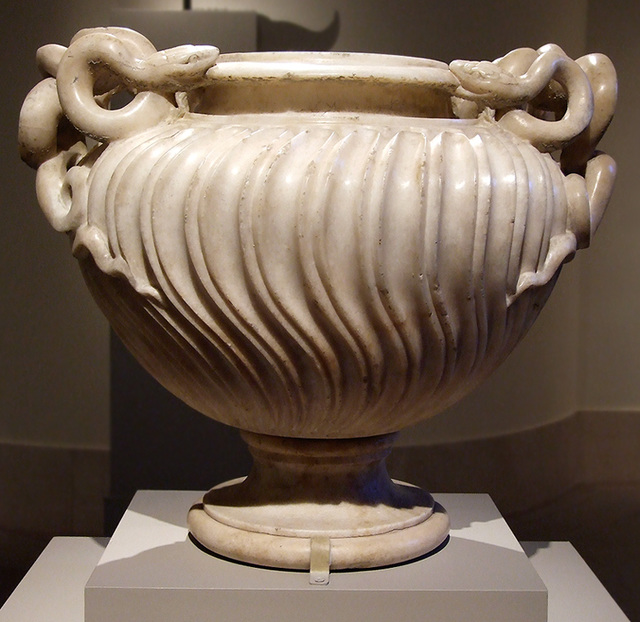Seated Torso of a Man in the Metropolitan Museum o…
Marble Strigilated Vase in the Metropolitan Museum…
Marble Pediment of a Funerary Altar in the Metropo…
Marble Relief Fragment of an Animal Hunt from Sard…
Detail of a Marble Pediment of a Funerary Altar in…
Seated Statue of Gudea in the Metropolitan Museum…
Seated Statue of Gudea in the Metropolitan Museum…
Seated Statue of Gudea in the Metropolitan Museum…
Assyrian Reliefs in the Metropolitan Museum of Art…
South Italian Wall Painting in the Metropolitan Mu…
Detail of a South Italian Wall Painting in the Met…
Marble Relief of Herakles in the Metropolitan Muse…
Marble Relief of Hermes in the Metropolitan Museum…
Marble Relief of Hermes in the Metropolitan Museum…
Marble Male Cycladic Figurine in the Metropolitan…
Detail of a Roman Mosaic Floor Panel in the Metrop…
The "Cellini Cup" Ewer in the Metropolitan Museum…
The "Cellini Cup" Ewer in the Metropolitan Museum…
Perseus by Canova in the Metropolitan Museum of Ar…
Detail of the Foot of Perseus by Canova in the Met…
The Demidoff Table in the Metropolitan Museum of A…
Detail of the Demidoff Table in the Metropolitan M…
Detail of the Demidoff Table in the Metropolitan M…
Detail of a Foot of the Monumental Bronze Statue o…
Detail of a Foot of the Monumental Bronze Statue o…
Detail of the Midsection of the Monumental Bronze…
Detail of the Head of the Monumental Bronze Statue…
Detail of the Monumental Bronze Statue of the Empe…
Detail of the Monumental Bronze Statue of the Empe…
Detail of the Monumental Bronze Statue of the Empe…
Monumental Bronze Statue of the Emperor Trebonianu…
Monumental Bronze Statue of the Emperor Trebonianu…
Monumental Bronze Statue of the Emperor Trebonianu…
Monumental Bronze Statue of the Emperor Trebonianu…
Reconstruction Drawing of a Statue of Trebonianus…
Head of a Ruler in the Metropolitan Museum of Art,…
Standing Male Worshiper in the Metropolitan Museum…
Bronze Statuette of a Lar in the Metropolitan Muse…
Bronze Statuette of a Lar in the Metropolitan Muse…
Paris by Canova in the Metropolitan Museum of Art,…
Paris by Canova in the Metropolitan Museum of Art,…
Detail of the Plaster Model of Cupid & Psyche by C…
Plaster Model of Cupid & Psyche by Canova in the M…
Plaster Model of Cupid & Psyche by Canova in the M…
The Visitation in the Metropolitan Museum of Art,…
Location
See also...
Keywords
Authorizations, license
-
Visible by: Everyone -
All rights reserved
-
454 visits
Marble Strigilated Vase in the Metropolitan Museum of Art, July 2007


Marble strigilated vase with snake handles
Roman, Antonine period, 2nd half of the 2nd century AD
The foot is restored.
Accession # 2007.31a, b
This marble vase with handles in the form of entwined serpents is arguably the finest and best preserved example known today of a type of Roman vessell with a strigilated pattern carved on the body. These elongaged S-shaped channels were a popular form of relief decoration on vases and sarcophagi, especially in the second half of the 2nd century and the 3rd century AD. Two bearded snakes form the handle on either side of the vase. With their upper bodies coiled on the broad shoulder, they stretch their flat heads forward across the deep concavity of the neck to bite the projecting rim, setting up a play of spatial depth and light and dark effects. The motif of entwined serpents is appropriate for a funerary vase. Linked with the earth, snakes were associated chthonian powers, and the Greeks and Romans regarded them as guardians of sacred places, houses, and tombs. In the absence of a funerary inscription, however, it is not possible to determine whether this vase was originally intended as an ash urn or for purely decorative use.
Text from the Metropolitan Museum of Art label.
Roman, Antonine period, 2nd half of the 2nd century AD
The foot is restored.
Accession # 2007.31a, b
This marble vase with handles in the form of entwined serpents is arguably the finest and best preserved example known today of a type of Roman vessell with a strigilated pattern carved on the body. These elongaged S-shaped channels were a popular form of relief decoration on vases and sarcophagi, especially in the second half of the 2nd century and the 3rd century AD. Two bearded snakes form the handle on either side of the vase. With their upper bodies coiled on the broad shoulder, they stretch their flat heads forward across the deep concavity of the neck to bite the projecting rim, setting up a play of spatial depth and light and dark effects. The motif of entwined serpents is appropriate for a funerary vase. Linked with the earth, snakes were associated chthonian powers, and the Greeks and Romans regarded them as guardians of sacred places, houses, and tombs. In the absence of a funerary inscription, however, it is not possible to determine whether this vase was originally intended as an ash urn or for purely decorative use.
Text from the Metropolitan Museum of Art label.
- Keyboard shortcuts:
Jump to top
RSS feed- Latest comments - Subscribe to the comment feeds of this photo
- ipernity © 2007-2024
- Help & Contact
|
Club news
|
About ipernity
|
History |
ipernity Club & Prices |
Guide of good conduct
Donate | Group guidelines | Privacy policy | Terms of use | Statutes | In memoria -
Facebook
Twitter

Sign-in to write a comment.